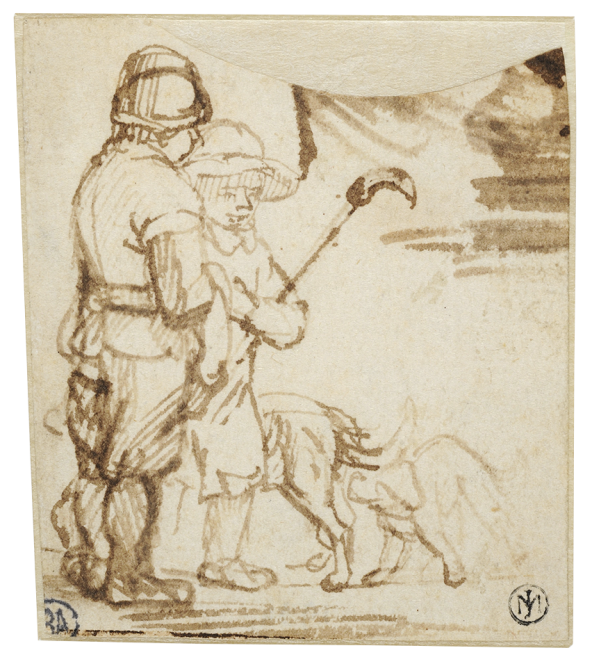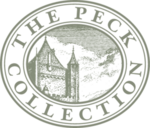Choose a background colour
Samuel van Hoogstraten, Dutch, 1627-1678: Studies of Three Standing Figures and a Head, c. 1645-50
Pen and brown with brown wash on paper.
4 1⁄2 × 3 in. (11.4 × 7.6 cm)
Verso, upper center, in pencil, Eeckhout? / Swg Suermondt; lower left, 8124; and lower center, 7863 / C770.
- Chain Lines:
- Horizontal, 24-26mm
- Watermark:
- None.
- Provenance:
Barthold Suermondt, 1818– 1887, Aachen (Lugt 415, blind stamp on recto); his sale, F. A. C. Prestel, Frankfurt, 5 May 1879, lot 139 (as School of Rembrandt, perhaps Gerbrand van den Eeckhout); dealer, C. G. Boerner, Düsseldorf, 1968 (Neue Lagerliste, no. 8); dealer, John Cassayd-Smith, London, 1989; sale, Sotheby’s, New York, 23 January 2001, lot 143; Sheldon and Leena Peck, Boston (Lugt 3847); gift to the Ackland Art Museum, inv. no. 2017.1.44.
- Literature/Exhibitions:
E. Trautscholdt in dealer cat. Boerner 1968 (as Barent Fabritius, or possibly Samuel van Hoogstraten); Sumowski Drawings, vol. 5 (1981), 2802 – 03, no. 1266x (as Van Hoogstraten); Blanc 2008, 346, no. D147 (as Van Hoogstraten)
- Ackland Catalogue:
- 2017.1.44
In his 1678 treatise, The Visible World, Samuel van Hoogstraten wrote: “It is therefore very useful and necessary to start early doing much drawing after life. And even though the schools with nude sessions are not always available, there is no lack of subject matter.” 1
After completing his training, Van Hoogstraten, like many artists, continued to draw studies from life as a regular practice to keep his skills honed. Here, he captured working-class figures going about their business in the streets around him. Though the three full-length figures appear to have been drawn separately, he placed them in relative diminishing scale on the sheet. This arrangement creates a mise-en-page suggestive of a cohesive composition (perhaps reflexively) despite the figures’ obvious mental and conceptual isolation from each other.
The Peck drawing is one of a number of such studies to survive that must have belonged to one of Van Hoogstraten’s sketchbooks.2
Others have likewise been trimmed from a larger sheet, evident here by the head study on the left edge that has been cut through the middle. Judging from the provenance, this probably occurred sometime in the nineteenth century. Two related sheets in the École des Beaux-Arts, likewise cropped, bear close stylistic similarities to the present drawing Fig. 23.1,Fig. 23.2.3

Samuel van Hoogstraten, Sheet of Studies with a Man and a Woman, c. 1650. Pen and brown ink on paper, 118 × 76 mm. Paris, École Nationale Supérieure des Beaux-Arts, inv. no. Mas.1935.
Beaux-Arts de Paris, Dist. RMN-Grand Palais/Art Resource, NY

Samuel van Hoogstraten, The Little Shepherds, c. 1650. Pen and brown ink on paper, 62 × 55 mm. Paris, École Nationale Supérieure des Beaux-Arts, inv. no. Mas.1934.
Beaux-Arts de Paris, Dist. RMN-Grand Palais/Art Resource, NY
Consensus that Van Hoogstraten was the author of these three works was only achieved after a number of alternative artists had been suggested, though scholars have long looked among members of Rembrandt’s circle. In the nineteenth century, the Peck drawing was thought possibly to have been the work of Gerbrand van den Eeckhout (1621 – 1674).4
Eduard Trautscholdt rejected this attribution in 1968 and gave it to Barent Fabritius (1624 – 1673), with the suggestion that it might also be by Van Hoogstraten.5
The latter attribution was adopted by Werner Sumowski, who published it with a group of other similar figure study sketches by Van Hoogstraten in his corpus of drawings by the artist.6
Sumowski had attributed the two related drawings in the École des Beaux-Arts, by contrast, to Nicolaes Maes.7
More recently, Peter Schatborn rightly argued for Van Hoogstraten’s authorship for those as well, based on a comparison of more rounded forms of the figures than in Maes’s sketches (which tend to be more angular) and the small zones of hatching that one finds in some of his other signed or securely attributed drawings.8
Some affinity between Van Hoogstraten’s and Maes’s works is not entirely surprising since both artists hailed from Dordrecht and had studied with Rembrandt in the 1640s.9
This is one of the best realized of Van Hoogstraten’s small study drawings from life, showing an artist adroitly at work trying to capture the attitude and bearing of the subjects before him, and lending a sense of character to the figures in the process. Sumowski’s suggestion that this sheet dates to the late 1640s is a reasonable one.10
It was perhaps made during his final years with Rembrandt in Amsterdam or during his early career as an independent master in Dordrecht, where he had returned in 1648 for a few years before embarking on a multiyear journey across Europe in 1651.
End Notes
Translation taken from Brusati & Jacobs 2021, 87. For the original text, see Van Hoogstraten 1678, 35.
Sumowski Drawings, vol. 8, nos. 1877x –78x (as Nicolaes Maes); and Lugt 1950, nos. 509 – 10 (as School of Rembrandt, undoubtedly Maes).
The drawing bears a nineteenth-century attribute to Van den Eeckhout on the verso, and it was sold as a work possibly by him in the sale of the Suermondt collection in 1879; see the Provenance above.
Trautscholdt in dealer cat. Boerner 1968, no. 8.
Sumowski Drawings, vol. 8, nos. 1877x –78x . The attribution to Maes was first suggested by Frits Lugt, though he catalogued the works as School of Rembrandt; see Lugt 1950, nos. 509 – 10
P. Schatborn in Paris & Ajaccio 2012 – 14, 108 – 09, nos. 29a, 29b, citing also the earlier opinion by William Robinson that the first of these drawings (cat. no. 29a) was not the work of Maes; see Robinson 1996, 98, note 7.
It is uncertain if Van Hoogstraten and Maes overlapped in Rembrandt’s studio, since Van Hoogstraten was back in Dordrecht by 1648 at the latest and may have completed his training right around the time that Maes began his training with Rembrandt around 1646 – 47. For a summary of opinions about when Van Hoogstraten may have trained in Rembrandt’s studio, see Robinson 2011, 398, note 2. For the 1648 document that records him back in Dordrecht, see Roscam Abbing 1993, 36, doc. 13. For Maes’s period in Rembrandt’s studio and his possible relationship with Van Hoogstraten, see A. van Suchtelen in The Hague & London 2019 – 20, 25 – 27.
